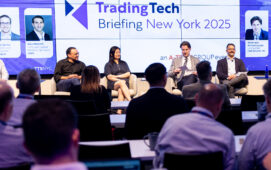Time series databases, predictive analytics, ultra-low latency network products, sophisticated algorithms and artificial intelligence are on the wish list of many trading firms looking for innovative technologies to improve trading architecture and support high performance trading. They do, however, come with challenges, cost implications and the need for management buy-in.
Speaking on a recent A-Team Group webinar covering innovation in trading architecture, Jason England, head of capital markets networks and hosting at TD Securities, noted that adoption of bleeding edge technologies has stagnated over the past few years, but is now on an upturn, although any new technology adoption must be proven to bring benefits.
In terms of types of high performance technologies finding favour at the moment, a poll of webinar participants noted time series databases, predictive analytics and ultra-low latency network solutions among top picks. These were augmented by Thomas Kennedy, head of analytic services at Thomson Reuters, who said the sell-side is looking at everything from data origination to quantum computing, while the buy-side is focussed on multi-asset and predictive tools that deliver efficiency, lower costs and speed to decisions. England added the potential of shortwave radio to reduce trans-Atlantic latency.
The challenges of implementing innovative trading tools include legacy systems and the difficulties of convincing management to make the necessary investment. The speakers suggested buy-in is sometimes dependent on whether a technology is a capital cost or a recurring payment, and noted that some technologies are easier to test than others and some may need to go through the proof of concept process. Cloud solutions offer the best try before you buy option.
Similarly, return on investment is easier to demonstrate with some solutions, such as FPGA network switches, while the return on less well-defined solutions or extensions to existing strategies is harder to quantify.
On a more technological level, the speakers discussed challenges of implementing new technologies including keeping clocks synchronised, data modelling to accurately map and link structured and unstructured data, and implementing standards such as FIX.
From a regulatory perspective, Bob Van Valzah, a former performance engineer at Sun Trading, said Markets in Financial Instruments Directive II (MiFID II) and forthcoming Fundamental Review of the Trading Book (FRTB) regulation will drive innovation in trading architecture to a limited extent.
With cost issues, technology challenges and regulation potentially holding back innovation, a final poll of the webinar audience drove home the rationale behind investment in new technologies for trading architecture with 86% of respondents gaining, or expecting to gain, improved trading performance, 71% new business opportunities, 71% reduced costs of trading, and 43% competitive advantage.
Subscribe to our newsletter




